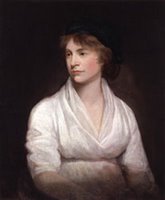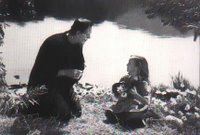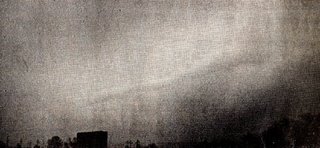 |
| The Ghost of Frankenstein, 1942 |
The 1931 film adaptation of Frankenstein I first saw one midnight in 1969 makes choices that run against the grain of Shelley’s novel, most notably in the accident which leads to a criminal brain being placed in the monster’s body. That famous moment, parodied with the “Abby Normal” brain in Mel Brook’s Young Frankenstein, suggests that the monster is inherently evil, leaving open the possibility that a better choice of brain might have led to a very different result.
But one thing director James Whale and actor Boris Karloff (and all the Universal filmmakers who followed in their footsteps) agreed upon was the fundamental innocence of the monster, and this is resonant in the film and the series of sequels. Like many other children before me, I loved the monster while being afraid of him, too. The first two murders he commits—of the hunchbacked assistant, Fritz, who tortures him for fun and of Dr. Waldman, who tries to euthanize him—are justifiable acts of self defense. The most disturbing scene--when he tosses the little girl who befriends him into a lake, drowning her—is clearly an accident. Children forgave the monster for that murder because they understood his confusion.
Though the film’s Dr. Frankenstein does not intentionally abandon his creation, at first. He does, however, neglectfully leave it in the abusive care of Fritz. He also leaves the monster to Dr. Waldman to put him to sleep, thus abdicating responsibility for what he has done.
And the fundamental idea that the creator and his creation are mirror images of one another is reinforced time and time again in the film. Explaining some of his motivation to go to such extremes of discovery, Dr. Frankenstein at one point comments, “My father never believes in anyone.” Later in the film, the creator and his creation face off twice—once on a barren mountainside, again staring at each other through the gears of a windmill. In both scenes, alternating close-ups of the creator’s face and that of his creation suggest that they are in some way one, bound together by destiny. It is easy to imagine Mary Shelley would have been pleased with these moments. At the end of what many feel is the superior sequel, Bride of Frankenstein, it is the monster who even has to take responsibility for bringing the horror to an end.
 |
| Dracula's Daughter, 1936 |
Like other viewers, as a child I understood that the monster was a kind of tragic hero, shaped by his environment and circumstance (particularly that torch-bearing mob). This too gets at Shelley’s purpose because such great tragedies as Paradise Lost and King Lear inspired her novel as much as the tales of the supernatural shared at Lake Geneva. And that tragic-hero quality lies at the heart of the majority of the Universal monsters. Dr. Jekyll, the Frankenstein monster, and The Wolfman’s Larry Talbot were all noble in their suffering. Even Count Dracula, who shows no more remorse for his impulses than the average carnivore tossed a steak, dreams of a day when he will find eternal rest. Gloria Holden, as Dracula’s daughter in the film of the same name, and John Carradine, particularly in House of Dracula, seem to genuinely want to bring their curses to an end. Certainly such lofty ambitions are not necessary for a good horror movie, but they are a hallmark of the movies that first ignited the censors.
Those who make horror recognize this double-bind of attraction and repulsion. One scene in particular finds its way from the poem “Christabel” that inspired Mary Shelley and echoes again and again in horror stories of the 20th Century. It is the image of a passionate embrace that culminates in horror. In “Christabel,” a man’s daughter (facing a father who will soon reject her—no wonder Mary picked up on it) recalls her midnight embrace with a female vampire (or witch, or demon, or all of the above), a memory that devolves into a realization that the breast she’d drawn to her own was cold and dead. In Frankenstein, the moment comes climactically, contributing to Victor’s tragic decision to flee from any responsibility for the monster.
Upon bringing his creature to life, he immediately suffers what might best be understood as a post-orgasmic fit of remorse—“now that I had finished, the beauty of the dream vanished, and breathless horror and disgust filled my heart.” That night he dreams of his love Elizabeth. He pulls her to him and kisses her, but “as I imprinted the first kiss on her lips, they became livid with the hue of death; her features appeared to change, and I thought that I held the corpse of my dead mother in my arms; a shroud enveloped her form, and I saw the graveworms crawling in the folds of the flannel.” Many times, this scene has been restaged since, maybe most vividly in that moment in Stanley Kubrick’s film version of The Shining when Jack Nicholson’s character attempts adultery, only to see the decomposing flesh of the beautiful woman in his arms reflected in the bathroom mirror behind her.
 In Danse Macabre, when Stephen King describes the cornerstones of modern horror, he talks of three different kinds of monsters. One (signified by Dracula) represents the evil from outside that invades our lives. The second (signified by Mr. Hyde or the werewolf) stands for the evil within us. But King describes the Frankenstein monster as “the thing with no name." All three suggest different aspects of alienation—the vampire externalizing our dark desires, the werewolf internalizing them. But the Frankenstein monster itself is a question mark (appropriately, the way Karloff’s performance is credited in the opening titles of the film). The horror, as much as anywhere else, lies in our reaction to this thing. What was The Shining’s Jack Torrance (Nicholson) thinking when he decided to make love to this thing that shouldn’t be? He was sent up to this hotel room because the occupant just finished trying to kill his son. A quickie should never have been in the cards.
In Danse Macabre, when Stephen King describes the cornerstones of modern horror, he talks of three different kinds of monsters. One (signified by Dracula) represents the evil from outside that invades our lives. The second (signified by Mr. Hyde or the werewolf) stands for the evil within us. But King describes the Frankenstein monster as “the thing with no name." All three suggest different aspects of alienation—the vampire externalizing our dark desires, the werewolf internalizing them. But the Frankenstein monster itself is a question mark (appropriately, the way Karloff’s performance is credited in the opening titles of the film). The horror, as much as anywhere else, lies in our reaction to this thing. What was The Shining’s Jack Torrance (Nicholson) thinking when he decided to make love to this thing that shouldn’t be? He was sent up to this hotel room because the occupant just finished trying to kill his son. A quickie should never have been in the cards.One of the things that is so useful about discussing Frankenstein at length is the way it mixes in each of the other horrors we have to explore. Frankenstein is inspired by a ghost and the monster becomes the ghost that haunts the doctor. The question of the line between sanity and insanity is richly complicated by the many degrees of sanity shown by both the “mad” scientist and his creation. The way in which the doctor becomes overwhelmed by his own creation suggests something of insignificance; just because we can do something doesn’t mean we have the qualities necessary to do the thing right. More importantly, though, King argues that Shelley’s chief influence on the horror that comes after her depends upon “splitting of the reader into two people of opposing minds: the reader who wants to stone the mutation and the reader who feels the stones and cries out at the injustice of it.” The horror of alienation, of being driven apart, particularly from that which one once loved, depends upon both an attraction and a repulsion.
Just as the doctor’s passion has awakened something he hates, the monster’s longing for human contact has turned him into something filled with hate. Certainly Shelley’s monster captures her own disappointment at being raised in such a way that she not only didn’t fit into society but she was also shunned by the generation that inspired her. Even still, the story also asks us to empathize with the cowardly father. With this two-way mirror approach to the horror, we gain a certain objective stance on our subjective reactions. The things that alienate us from one another are understandable. We can and do sympathize with both the action and the reaction. What Frankenstein leaves us with is a larger question than we anticipated. What do we do with this understanding of what drives us apart?
































